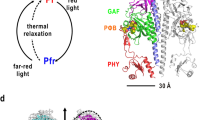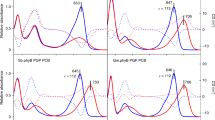Abstract
PHYTOCHROME is a plant photomorphogenetic pigment existing in two forms, Pr and Pfr, interconvertible by light, which have absorption peaks in the red and far-red regions of the spectrum respectively1,2. Intermediates between Pr and Pfr have been studied by several techniques in vivo and in vitro including flash photolysis3,4, low temperature spectroscopy5–7 and measurement of the dark (d) reactions of intermediates that accumulate in conditions of pigment cycling8–10. The pathways Pr→Pfr and Pfr→Pr have been shown to be different, but, both pathways involve an initial photoreaction of the chromophore, followed by a series of dark reactions10,11:  P698, P710, P650, P690 are intermediates having peak absorbance at 698, 710, 650 and 690 nm respectively; Pb1 and Px are intermediates having relatively weak absorption bands. I now report a technique enabling phytochrome intermediates to be studied in vivo at 0° C using a dual wavelength spectrophotometer.
P698, P710, P650, P690 are intermediates having peak absorbance at 698, 710, 650 and 690 nm respectively; Pb1 and Px are intermediates having relatively weak absorption bands. I now report a technique enabling phytochrome intermediates to be studied in vivo at 0° C using a dual wavelength spectrophotometer.
This is a preview of subscription content, access via your institution
Access options
Subscribe to this journal
Receive 51 print issues and online access
$199.00 per year
only $3.90 per issue
Buy this article
- Purchase on Springer Link
- Instant access to full article PDF
Prices may be subject to local taxes which are calculated during checkout
Similar content being viewed by others
References
Hillman, W. S., A. Rev. Pl. Physiol., 18, 301 (1967).
Briggs, W. R., and Rice, H. V., A. Rev. Pl. Physiol., 23, 293 (1972).
Linschitz, H., Kasche, V., Butler, W. L., and Siegelman, H. W., J. biol. Chem., 241, 3395 (1966).
Cross, D. R., Linschitz, H., Kasche, V., and Tenenbaum, J., Proc. natn. Acad. Sci., U.S.A., 61, 1095 (1968).
Pratt, L. H., and Butler, W. L., Photochem. Photobiol., 8, 477 (1968).
Spruit, C. J. P., and Kendrick, R. E., Photochem. Photobiol., 18, 145 (1973).
Kendrick, R. E., and Spruit, C. J. P., Photochem. Photobiol., 18, 139 (1973).
Briggs, W. R., and Fork, D. C., Pl. Physiol. Lancaster, 44, 1081 (1969).
Kendrick, R. E., and Spruit, C. J. P., Nature new Biol., 237, 281 (1972).
Kendrick, R. E., and Spruit, C. J. P., Photochem. Photobiol., 18, 153 (1973).
Kendrick, R. E., and Spruit, C. J. P., Pl. Physiol. Lancaster, 52, 327 (1973).
Kendrick, R. E., Spruit, C. J. P., and Frankland, B., Planta, 88, 293 (1969).
Tobin, E. M., and Briggs, W. R., Pl. Physiol. Lancaster, 44, 148 (1969).
Tobin, E. M., Briggs, W. R., and Brown, P. K., Photochem. Photobiol., 18, 497 (1973).
Balange, A. P., thesis, University of Rouen, France, (1973).
Author information
Authors and Affiliations
Rights and permissions
About this article
Cite this article
KENDRICK, R. Phytochrome intermediates in freeze-dried tissue. Nature 250, 159–161 (1974). https://doi.org/10.1038/250159a0
Received:
Issue Date:
DOI: https://doi.org/10.1038/250159a0
This article is cited by
Comments
By submitting a comment you agree to abide by our Terms and Community Guidelines. If you find something abusive or that does not comply with our terms or guidelines please flag it as inappropriate.



